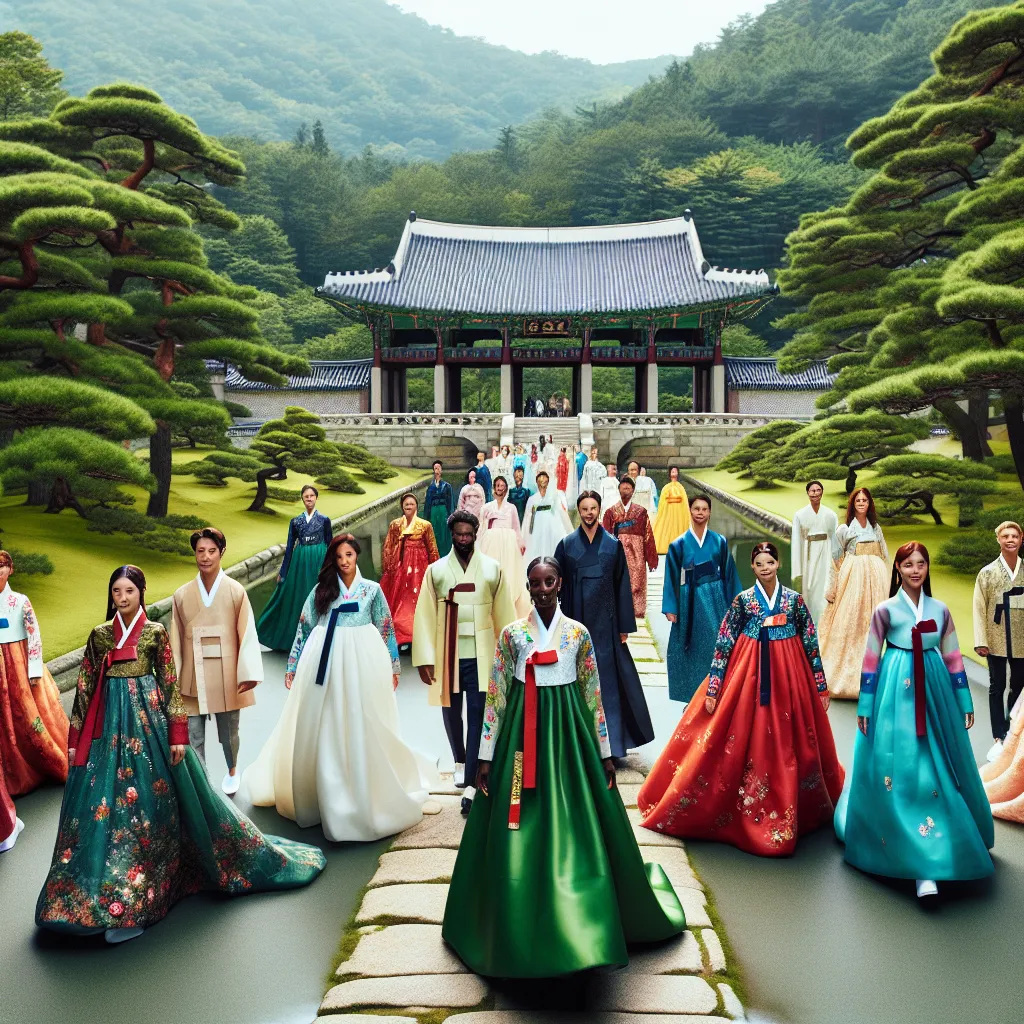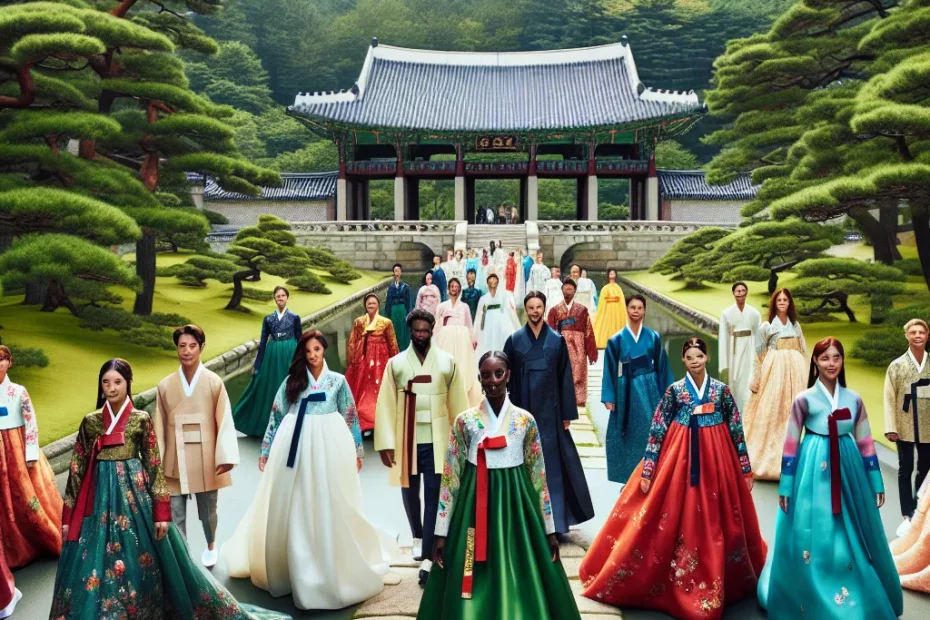Step into the world of traditional Korean culture with a unique and enriching experience – dressing up in Hanbok. Hanbok, the traditional attire of Korea, holds deep historical and cultural significance. By donning this beautiful garment, you not only adorn yourself in exquisite fabrics and designs but also immerse yourself in the rich heritage of Korea. Exploring the history and symbolism of Hanbok unveils a world of tradition and artistry, showcasing the elegance and grace of Korean attire. As you prepare to dress up in Hanbok, understanding the etiquette and customs associated with it adds a layer of respect and appreciation for this cultural practice. So, let’s delve into the world of Hanbok and discover the beauty and tradition it embodies.

Exploring the History of Hanbok
Embark on a fascinating journey through time as we delve into the rich history of Hanbok, the traditional attire of Korea. Dating back over 1,600 years, Hanbok has been an integral part of Korean culture, reflecting the country’s unique identity and heritage. 🌟
The Origins of Hanbok
The origins of Hanbok can be traced back to the Three Kingdoms period (57 BC – 668 AD), where distinct styles began to emerge based on social status and occasion. The basic structure of Hanbok, consisting of jeogori (jacket) and chima (skirt), has remained relatively unchanged throughout history, symbolizing the timeless elegance and grace of Korean fashion. 🌺
Evolution During the Joseon Dynasty
During the Joseon Dynasty (1392-1910), Hanbok underwent significant developments, with strict dress codes established to differentiate between social classes. The colors, fabrics, and designs of Hanbok were carefully regulated, with vibrant hues and intricate patterns reserved for the royal family and aristocracy. This attention to detail and symbolism elevated Hanbok to more than just clothing, but a visual representation of one’s place in society. 🏰
Revival and Modern Adaptation
As Korea transitioned into the modern era, Hanbok faced challenges in adapting to Western influences and changing lifestyles. However, in recent years, there has been a resurgence of interest in Hanbok, with designers incorporating traditional elements into contemporary fashion trends. This revival not only preserves the legacy of Hanbok but also celebrates its enduring beauty and cultural significance. 👘
Today, Hanbok continues to captivate people around the world with its timeless appeal and artistic craftsmanship. Whether worn during festive celebrations, weddings, or cultural events, Hanbok serves as a symbol of pride and connection to Korea’s past. By exploring the history of Hanbok, we gain a deeper appreciation for this iconic attire and the stories it carries through generations. 🌸
Join us in honoring the legacy of Hanbok and experiencing the elegance of Korean tradition firsthand. Let the vibrant colors, intricate designs, and graceful silhouettes transport you to a bygone era where clothing was more than just fabric, but a reflection of history, culture, and identity. 🌿
Experience the magic of Hanbok and embrace the beauty of Korea’s sartorial heritage like never before. Let the echoes of the past guide you on a journey of discovery and admiration for one of the world’s most exquisite traditional attires. 🌼
Understanding the Symbolism of Hanbok
Hanbok, the traditional Korean attire, holds deep cultural significance and symbolism that reflects the values and beliefs of Korean society. Each element of the hanbok, from the fabric to the colors, carries a specific meaning that has been passed down through generations. Let’s delve into the rich symbolism behind the hanbok and uncover the layers of tradition and history woven into this iconic garment.
The Symbolism of Colors
The colors of hanbok play a crucial role in conveying symbolism. For example, the color white symbolizes purity and modesty, while red is associated with passion and energy. Blue represents peace and harmony, and yellow signifies royalty and prosperity. By wearing hanbok in different colors, individuals can express their values and intentions without saying a word. The intricate patterns and designs embroidered on hanbok also hold symbolic meanings, often representing elements of nature, such as flowers, birds, and clouds, which symbolize beauty, freedom, and spirituality.
The Symbolism of Silhouette
The silhouette of hanbok is another aspect rich in symbolism. The flowing lines and voluminous shapes of hanbok reflect the Confucian ideals of modesty and humility. The loose fit of hanbok allows for freedom of movement, symbolizing the importance of comfort and practicality in everyday life. Additionally, the division of hanbok into upper and lower garments symbolizes the balance between yin and yang, the harmony of opposites that is central to Korean philosophy.
The Symbolism of Accessories
Furthermore, the accessories worn with hanbok also carry symbolic significance. The traditional headpiece, known as a binyeo, symbolizes marital harmony and fidelity. The use of jade ornaments in hanbok accessories symbolizes longevity and prosperity. Even the shoes worn with hanbok, such as the traditional straw shoes called gomusin, have symbolic meanings related to connection with the earth and nature.
In Korean culture, hanbok is not just a piece of clothing; it is a symbol of identity, heritage, and tradition. By understanding the symbolism behind hanbok, we gain a deeper appreciation for the cultural values and beliefs that have shaped Korean society for centuries. So, the next time you see someone dressed in hanbok, remember that they are not just wearing clothes – they are carrying on a legacy of symbolism and tradition that is truly timeless. 🌸👘🌿
Tips for Dressing Up in Hanbok
Are you ready to immerse yourself in the beauty of traditional Korean attire? Dressing up in Hanbok is not just about putting on clothes; it’s a cultural experience that allows you to step back in time and feel the elegance of the past. Here are some tips to help you make the most of your Hanbok experience! 💃🎎
Choosing the Right Hanbok
First and foremost, when choosing a Hanbok, pay attention to the colors and designs. Traditional Hanbok comes in a variety of vibrant colors such as red, blue, and yellow, each symbolizing different aspects of Korean culture. The intricate patterns and embroidery on the fabric also hold significant meaning, so take your time to appreciate the craftsmanship. 🎨✨
Wearing the Hanbok Properly
Next, make sure to wear the Hanbok properly. The skirt should be long enough to touch the floor, and the jacket should fit comfortably around your shoulders. Don’t forget to adjust the ribbon (goreum) to create a flattering silhouette. When dressed correctly, you’ll exude grace and elegance just like a Korean noble from centuries past. 👘🌟
Accessorizing Your Hanbok
Accessorizing is key to completing your Hanbok look. Add traditional Korean hairpins (binyeo) or a beautiful norigae (decorative tassel) to enhance your outfit. These accessories not only add a touch of authenticity but also showcase the intricate details of Korean craftsmanship. You’ll feel like a true royal walking through the streets of Seoul. 👑🌸
Embracing the Experience
Lastly, embrace the experience wholeheartedly. Walking in Hanbok may feel different from your usual attire, but let go of any self-consciousness and embrace the cultural significance behind each garment. Take the time to appreciate the beauty of Hanbok and the history it represents. You’ll not only look stunning but also feel a deep connection to Korean traditions. 🏯❤️
In conclusion, dressing up in Hanbok is more than just wearing traditional clothes; it’s a journey through time and culture. By following these tips and fully immersing yourself in the experience, you’ll not only look fabulous but also gain a deeper appreciation for Korean heritage. So, go ahead, don that Hanbok with pride and grace, and let the beauty of tradition envelop you! 🌺🌟
Etiquette and Customs when Wearing Hanbok
Welcome to the world of Hanbok, the traditional Korean attire that embodies elegance and grace. When dressing up in Hanbok, it is essential to understand the etiquette and customs associated with this cultural attire. Let’s delve into the intricate details that make wearing Hanbok a truly special experience!
Respect for Tradition
Hanbok is not just a piece of clothing; it is a symbol of Korea’s rich cultural heritage. When wearing Hanbok, it is important to show respect for the tradition and history it represents. This includes understanding the significance of the different colors and designs used in Hanbok, as each element holds a deeper meaning.
Proper Fit and Arrangement
One key aspect of Hanbok etiquette is ensuring that the attire fits properly and is arranged correctly. The skirt of the Hanbok should be ankle-length, and the jeogori (jacket) should be buttoned up neatly. Pay attention to the way the sash (gorum) is tied, as it can vary depending on the occasion and the wearer’s marital status.
Mindful Movements
When wearing Hanbok, it is important to be mindful of your movements. The skirt of the attire is voluminous and flowy, so take care when walking to avoid stepping on it. Additionally, when sitting down, gather the fabric of the skirt gracefully to maintain the elegant appearance of the Hanbok.
Accessories and Hairstyles
Completing the Hanbok ensemble involves choosing the right accessories and hairstyle. Women often wear traditional hair ornaments like binyeo, while men may opt for a gat (traditional hat). These accessories add an extra touch of authenticity to the overall look and should be selected with care.
Special Occasions
Hanbok is commonly worn during special occasions such as weddings, Lunar New Year, and traditional ceremonies. Understanding the customs and etiquette specific to each event is crucial when donning Hanbok. For example, the colors and designs of Hanbok worn to a wedding may differ from those worn during a harvest festival.
Appreciation for Craftsmanship
Lastly, when wearing Hanbok, take a moment to appreciate the craftsmanship and artistry that goes into making each piece. Hanbok is meticulously crafted with attention to detail, making it a true work of art. By wearing Hanbok with reverence and appreciation, you honor the artisans who have preserved this tradition for generations.
In conclusion, wearing Hanbok is not just about putting on a beautiful outfit; it is a way to connect with Korea’s cultural roots and heritage. By following the etiquette and customs associated with Hanbok, you can truly embody the elegance and grace of this traditional attire. Embrace the traditions, respect the customs, and enjoy the enriching experience of dressing up in Hanbok!
Immerse yourself in the rich cultural heritage of Korea by experiencing the beauty and elegance of traditional Hanbok attire. Through the intricate designs and vibrant colors of Hanbok, you can connect with centuries of history and tradition. By understanding the symbolism behind each element of Hanbok, you gain a deeper appreciation for its significance in Korean culture. When you dress up in Hanbok, you not only honor the past but also create lasting memories for yourself. Remember to follow proper etiquette and customs while wearing Hanbok to show respect for the tradition. Embrace the opportunity to step into the shoes of the past and feel the pride of wearing Hanbok. Experience the grace and charm of this timeless attire, and let it transport you to a bygone era of elegance and beauty.
